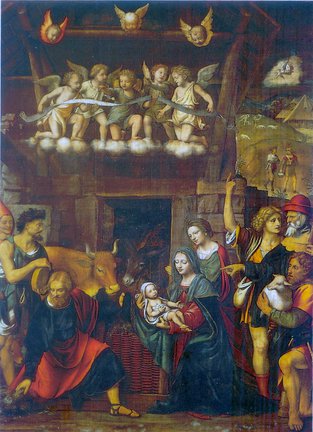Campata sinistra 4
La quarta campata era anticamente dedicata alla Crocefissione. Dal primo ‘800 è dedicata a San Giuseppe.
L’altare fu completamente rifatto dal 1830 su disegno dell’arch. Giacomo Moraglia.
È opera di diversi artisti: Giovan Battista Argenti di Viggiù smontò il vecchio altare e montò il nuovo sotto la direzione dell’architetto della Fabbrica Melchiorre Nosetti. L’Argenti scolpì anche la balaustra disegnata dal nuovo architetto della Fabbrica, il ticinese Biagio Magistretti. Ma l’opera principale è il gruppo di S. Giuseppe con Gesù adolescente dello scultore neoclassico milanese Pompeo Marchesi autore anche del paliotto a rilievo con il Transito di san Giuseppe e della cimasa con gli Angeli e il Padre Eterno.
I quadri laterali sono due tele a tempera: a sinistra lo Sposalizio della Vergine di Gaudenzio Ferrari, a destra la Natività di Bernardino Luini, dipinti databili al terzo decennio del XVI secolo. I due dipinti erano ante di chiusura dell’altare di S. Abbondio nella contrapposta quarta cappella della navata meridionale. Furono smontati nel 1815.
Verso la navata centrale è esposto lo stendardo rinascimentale della Confraternita di S. Abbondio fra i santi Proto e Giacinto, che proteggono confratelli e consorelle. La teca fu disegnata nel 1901 dall’arch. Federico Frigerio, l’architetto comasco che avrebbe poi restaurato prima la facciata del Duomo strapiombante, poi la cupola incendiata.
L’altare di S. Giuseppe era in origine dedicato alla Crocifissione, come indica la chiave di volta con la Luna personificata e coll’espressione triste mentre oscura il Sole, immagine dell’eclissi ed emblema della Crocifissione, durante la quale il sole si oscurò. L’altare era pure dedicato a Santa Pelagia.
Da questo altare proviene il gruppo ligneo della Crocifissione che si ammira più avanti nell’ultima cappella.
Di questo altare era titolare la Confraternita del Ss. Crocifisso, poi associata a quelle del Ss. Corpo di Cristo e a quelle di S. Abbondio e di S. Sebastiano ed infine tutte assorbite a fine ‘500 in quella del Ss. Corpo di Cristo.
Davanti all’altare c’erano due sepolcri per i confratelli. Gli altri parrocchiani erano sepolti nella distrutta chiesetta di S. Stefano.
In questo altare sono state riposte le reliquie di metà dei corpi dei santi vescovi Rubiano ed Adalberto, dapprima sepolti in S. Abbondio, poi in Duomo dietro l’altare del Crocifisso. L’altra metà stava nella chiesa domenicana di S. Giovanni Pedemonte, poi trasferita nella basilica dell’Annunciata di Como nel sarcofago all’altare della Vergine.
Il primo altare di S. Giuseppe fu eretto in Duomo nel triennio repubblicano francese (1803-1805) per iniziativa, non avallata dai fabbricieri, in quel periodo esautorati, dell’orefice Giuseppe Ghizzoni mentre la vicina chiesa di S. Giacomo veniva temporaneamente sconsacrata e ridotta a stalla dai francesi: là l’altare era dedicato a S. Carlo nella Cappella della Carità. Fu poi rimosso dal Duomo perché troppo alto e di stile barocco.
Quell’altare fu rimontato nella chiesa di S. Giacomo ed è dedicato alla Madonna.
Si ignora la fine della prima statua di S. Giuseppe, opera di un milanese.




